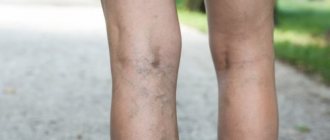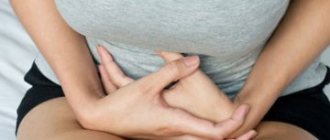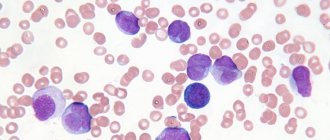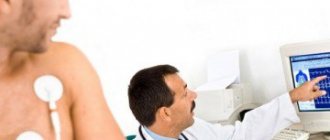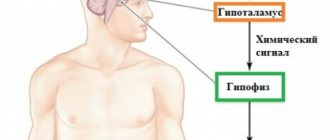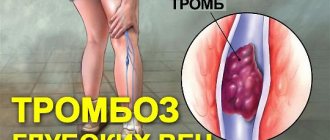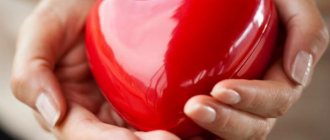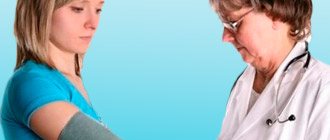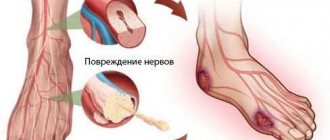- What kind of illness is this?
- Causes
- Symptoms at different stages of political science
- Features of internal varicose veins
- Consequences
- How to treat internal varicose veins?
- Prevention
Middle-aged people often suffer from internal varicose veins, which is caused by excessive weakening of the valve system. The symptoms of this disease are varied and appear as the pathology develops, so it is important to diagnose the disease in the early stages, which will allow effective treatment measures to be taken and serious complications to be prevented.
Provoking factors
There are some factors that contribute to the development of the disease. Here is their list:
- Heredity (insufficient development of connective tissue of the venous walls, congenital inferiority of valves). The most common cause, which is detected in about a third of patients.
- Professional activities associated with prolonged standing or, conversely, in a sitting position.
- Insufficient physical activity.
- Physical overload.
- Poor diet with a predominance of fast food, fatty foods, carbonated drinks.
- Excess body weight.
- Smoking and drinking alcoholic beverages.
- Abuse of caffeinated drinks.
- Hormonal changes (pregnancy, menopause, menstruation, use of contraceptives).
- Frequent constipation.
- Increased blood sugar.
- Liver diseases.
- Inflammatory diseases of the genital organs.
- Stress, neurological disorders. Violation of nervous regulation leads to a decrease in venous tone and an increase in the diameter of blood vessels.
- Elevated cholesterol levels.
- Wearing heels and tight shoes.
Pregnant women are at particular risk for this disease. This is explained by hormonal changes occurring in the female body. Certain hormones reduce the elasticity of vascular walls and promote blood stagnation. In addition, in the last trimester, the stomach increases significantly in size and compresses the blood vessels. For some women, problems go away after childbirth, for others, varicose veins progress further. Read more about varicose veins after childbirth here.
Also, venous disorders often bother young girls. This is due to the fact that many people use oral contraceptives, which change hormonal levels.
Watch this video and you will find out what doctors think and advise when a similar problem occurs in pregnant women.
Damage to the veins of the hemorrhoidal ring
Since the disease begins almost unnoticed, it gradually progresses, causing severe discomfort in the affected area. The development of pathology is accompanied by deformation of the venous vessels inside the rectum or around the anus (internal/external hemorrhoids).
The list of main provoking factors includes:
- persistent problems with bowel movements (constipation, prolonged diarrhea);
- pregnancy;
- difficult birth.
Such conditions are characterized by increased tension in the perineal muscles and increased pressure in the hemorrhoids.
The risk of a disorder increases if:
- sedentary lifestyle;
- frequent consumption of spicy foods;
- strong physical activity;
- hereditary predisposition.
Acute hemorrhoids are accompanied by:
- hemorrhages from the anus during or after bowel movements;
- itchy sensations;
- swelling of the anus;
- intense pain;
- prolapse of nodes or their protrusion with external hemorrhoids;
- inflammatory process;
- temperature increase (local/general).
The painful sensations can be so intense that the woman loses the opportunity to lead her usual lifestyle.
A severe form of the disease can be complicated by purulent inflammation of the perineal tissue or thrombosis. The nodes may become covered with ulcers. There is a possibility of sepsis.
For moderate symptoms, conservative treatment is provided, which is supplemented by diet and exercise therapy. If the disease is advanced, surgery is prescribed using minimally invasive techniques. In extreme cases, surgical removal of existing nodes is performed.
Characteristic symptoms and types
Most often, the disease affects the lower extremities, since they bear a heavy load every day.
Varicose veins may have certain symptoms. Among them:
- heaviness in the lower extremities (especially in the evenings);
- spider veins (telangiectasia) on the skin;
- areas of pigmentation in the affected area;
- burning and swelling in the calf area;
- feeling of crawling sensations;
- enlarged veins;
- transillumination of bluish tortuous veins through the skin;
- swelling of the legs and feet;
- eczema and dermatitis due to thinning of the skin;
- involuntary spasms of the calf muscles;
- prolonged healing of wounds and bruises.
It should be noted that symptoms increase significantly after physical activity!
In addition to the legs, varicose veins in women often affect other parts of the body. Let's consider the possible options:
- Upper limbs. Characteristic signs appear: swelling and pain in the fingers, cramps at night. As the pathology progresses, it becomes difficult for a woman to cope with household chores.
- Small pelvis. Such varicose veins are characterized by the appearance of aching pain in the lower abdomen (with irradiation to the sacrum or lower back). Symptoms may resemble cystitis, enterocolitis, inflammatory processes in the genitals. Problems with urination and intimacy often occur.
- Groin. The venous pattern is visible visually on the thighs (upper part), labia, buttocks, and groin area. Painful sensations are localized not only at the site of the lesion. But they also spread to the genitals, perineum and lower back. The skin becomes dry and thin.
- Hemorrhoidal veins. The appearance of hemorrhoidal cones in the anus is characteristic. They can fall out, become injured and bleed. Such patients complain of itching, burning and pain, aggravated by defecation.
Consequences
If the internal dilatation of the veins of the internal extremities is ignored, serious complications are likely to follow. The pressure in the venous vessels increases, and oxygenated blood enters in small quantities. In this case, hypoxic changes occur at the level of cellular structures and toxic compounds accumulate. All this leads to the following consequences:
- Trophic ulcers form on small wound surfaces of the lower leg area, which then also appear in the ankle area. They cause severe pain, take a long time to heal and open easily. This condition can cause disability for the patient if therapy that restores venous blood flow is not carried out in a timely manner.
- Blood clots form on the venous walls, which can clog the lumen and cause acute phlebothrombosis. When the blood clots break off, they penetrate into the pulmonary arterial vessel, which causes pulmonary embolism. A complication appears in the form of swelling of the lower leg area. The patient experiences severe pain and breathing problems, and this condition can be fatal. Surgery required.
- A rupture of the nodal vein occurs due to depletion of its walls. This causes hemorrhage, often leading to death. When the vein ruptures, the patient feels severe pain. In this case, hemorrhages occur and hematomas are formed, which will fester in the future if they are not treated correctly. Rupture of a varicose vein can lead to sepsis.
Stages
The stage of the disease determines the treatment regimen. There are four degrees of the disease:
- First. Only minor cosmetic defects appear. The woman remains fully functional.
- Second. The outflow of blood is impaired in one or more venous ducts. Such a patient has reduced performance, and appropriate therapy is necessary to maintain it.
- Third. Venous outflow is significantly impaired in the superficial and perforating veins. The woman does her usual work for 7 hours with constant supportive treatment.
- Fourth. Severe blood reflux, expansion of deep veins. Work ability suffers even with treatment.
Clinical picture
Internal varicose veins are a disease characterized by swelling of nodular veins hidden in the deep layers of the skin. The occurrence of the pathology is associated with the spread of varicose veins from the superficial veins through perforated venous vessels. The development of the disease is facilitated by stagnation of blood in the veins, their expansion and damage.
The pathology affects people over the age of 30, because it is at this time that the venous valves wear out. According to statistics, 60% of women and 35% of men over 45 years of age are affected by the disease.
The development of varicose veins of the pelvis is typical for women over 30 years of age.
Diagnostics
During the initial examination, the doctor carefully interviews the patient and conducts an objective examination. After this, the necessary diagnostic measures are prescribed.
- Duplex ultrasonography. The method allows you to obtain accurate information about the functional state of the veins.
- Rheovasography. With this non-invasive examination, circulation disorders and changes in the venous walls can be detected.
- Phlebography. A reliable test that displays the condition and capacity of superficial and deep veins.
Treatment
Treatment of varicose veins is carried out by highly specialized specialists - phlebologist and vascular surgeon. Treatment is carried out in several ways:
- medicines;
- compression jersey;
- physiotherapy;
- ethnoscience;
- physiotherapy;
- surgical intervention.
Medicines
At the initial stage of the disease, it is quite possible to get by with local treatment. For this, special creams and ointments are used:
- Venitan;
- Troxevasin;
- Venolife;
- Heparin ointment;
- Lyoton.
They must be applied regularly two or three times a day to clean skin.
In more serious cases, doctors prescribe tablet medications:
- Disaggregants (Actovegin, Trental, Curantil). These medications reduce platelet aggregation and prevent thrombus formation.
- Phlebotonics (Phlebodia 600, Detralex). They improve blood flow and eliminate congestion.
Compression jersey
Wearing compression stockings is recommended for patients in almost all cases. This has the following positive effects:
- the volume of veins decreases;
- blood flow improves;
- the absorption of tissue fluid into the bloodstream increases, heaviness and swelling in the legs go away.
When choosing a medical product, it is better to give preference to well-known brands: Intex, Orto, Relaxan, Sigvaris.
Knitwear is selected taking into account the individual characteristics of the patient and the stage of the disease. These can be tights, knee socks, stockings, elastic bandages.
Therapeutic exercises
Doing simple exercises daily has a good healing effect. Here are some of them:
- Alternately raising your heels off the floor from a standing position.
- Rise and fall on your toes with both legs at the same time.
- Circular rotation of the feet (one way and the other)
- Bicycle (from a supine position).
Each of them is performed within 3-5 minutes. It's better to do this daily.
In addition, swimming and walking (not exhausting) are useful.
Surgery
Complicated varicose veins of the third stage often require surgical treatment. In the fourth stage, surgery is a necessity. Possible options:
- Sclerosis. A special solution is injected into the diseased veins. Its “task” is gluing the venous walls and narrowing the venous lumen.
- Phlebectomy. This intervention is aimed at excision of pathologically dilated and altered veins.
- Stripping. The damaged vein is pulled out using a special hook.
- Laser coagulation. The damaged vein is cauterized from the inside, after which it gradually resolves.
Physiotherapy
Among the physiotherapeutic methods for the treatment of varicose veins are:
- magnet;
- darsonvalization;
- laser;
- ultrasound;
- cryotherapy;
- ozone therapy.
Traditional treatment
Traditional medicine has a large number of remedies that help improve the condition of the veins and alleviate the course of the disease.
Ginseng
This plant has a tonic effect and helps well in the treatment of vascular diseases. It is actively used for the preparation of ointments and gels. Internal use is also possible (in the form of an alcohol tincture).
Tincture recipe: pour dried ginseng (200 g) with vodka (500 ml) and put in a dark, cool place for two weeks.
The finished tincture should be taken one teaspoon before meals (up to three times a day).
Kalanchoe
A tincture is prepared from this medicinal plant for the treatment of varicose veins (for external use).
Recipe: cut fresh leaves should be placed in a glass container (up to half) and filled with vodka until full. Place in a dark place for two weeks.
The duration of treatment is 2-4 weeks.
Nettle
A decoction is prepared from stinging nettle for internal use.
Recipe: 200 g of nettle leaves are poured with a liter of water and placed on low heat for 30 minutes. After infusion, drink a quarter glass throughout the day.
Soda
This simple and budget-friendly product can be found in every home. It has long been used to treat varicose veins. To do this, soda (one teaspoon) should be diluted with a small amount of warm water (a third of a glass). The resulting solution is used to wipe sore spots. There is no need to wash it off.
You can also make compresses with baking soda. Recommended exposure time is 40 minutes.
Another good way is soda baths. It is advisable to take them for a large affected area. To prepare such a bath, you need to dissolve four tablespoons of soda in hot water in a separate container, and pour the resulting composition into the filled bath. The course requires 10 procedures, 2 times a week.
Garlic
It is used as part of medicinal compresses. To do this, the head of garlic is crushed through a press and mixed with butter in a ratio of 1:2. Such compresses are applied to the protruding veins overnight and wrapped with a warm scarf. With daily procedures, relief comes very quickly.
Prevention
Preventing a disease is much easier than treating it later. Therefore, you should not neglect the recommendations of specialists on its prevention. Here are the main ones:
- avoid heavy physical activity;
- give up bad habits (alcohol, cigarettes);
- control weight;
- establish proper nutrition;
- refuse high-heeled shoes;
- include moderate physical activity in your daily routine;
- use a contrast shower;
- Regularly visit a gynecologist and get tested for hormones.
Varicose veins are a chronic disease, so you cannot get rid of them completely. But it is quite possible to prevent complications and slow down progression. Since in women the disease occurs in a more severe form, even with minimal changes you should seek help from a specialist.
Contraindications for varicose veins
During varicose veins it is prohibited:
- Don't control your weight. Even if “obesity” has not been detected, excessive tension on the legs does not help eliminate problems with the veins;
- Lead a passive lifestyle , and therefore the blood pressure in the vessels will increase. Leg work needs massage every day and exercises to improve blood circulation;
- Do “strength” exercises - squats or push-ups with weights;
- Do intense exercises on an exercise bike , running or playing active sports. You need to postpone this until the doctor allows you to exercise. What kind of gymnastics to do for deep vein thrombosis of the lower extremities?
- “Cupping” and “honey” massages. Excessive impact on overloaded vessels can be harmful, as opposed to softer self-massage, where the legs are gently massaged;
- Use hormonal drugs without consulting a specialist. If there are primary signs of varicose veins, you should be examined and notify your doctor about the use of hormones;
- Wear high-heeled shoes . If you carry out therapy on time, you will soon no longer need to feel complex about the disease.
